#dnd pantheon
Text
Goddess Eldath

Violence serves no end but to create more violence. There is a better way - let me show you.
Eldath is the guardian of groves, and her presence is felt wherever there is calm. She is also regard ed as a goddess of serenity, comfort, and healing. Any waters blessed by her are known to cure sickness and madness. They can also calm the dying, giving them peace and a natural passing.
Eldath is a pacifist who avoids hostile action, even if threatened. Although she, quiet, and enigmatic, Eldath is possessed of unknown depths of character and unexpressed resolve that cannot be broken. She meets challenges by strategically withdrawing, a course of action that in time always leads opponents to overextend into an untenable position in which their reinforcements have been converted to her side. Recently she has been suffering many attacks from Malar and his followers, with the People of the Black Blood despoiling several of her sacred pools.
Worshippers
In a world brimming with evil deities and their servants, ogres, goblins, warring nations, and other hostile forces, it is not surprising that Eldath's philosophy of peace and calm has failed to catch on. Still, legends speak of heroes who embraced the cause of Eldath and abandoned warfare forever. One race of beings who travel against the tide of war with Eldath are the ondonti, a pacifistic orcish race.
Eldathyns were organized into a simplistic hierarchy, where priests reported to a local high priest responsible for a realm or larger region. Most followers dwelt in quiet forest communities with open-air sacred places of worship or in woodside cottages, far from the baseness of city life; both often containing pools of placid water in unspoiled areas. They rarely ever engaged in open confrontation and always acted subtly and peacefully.
Her clergy often followed migratory patterns traveling from holy site to holy site in a local area. They took care of the holy sites and allied with the local druids who followed the First Circle, of which Eldath was considered a member. Violence of any kind against an Eldathan priest was considered taboo, and murdering one was said to bring extremely bad luck. Even so, most servants of Eldath preferred to avoid conflict rather than trying to pacify it because they understood that peace cannot be forced. They would happily preside over peaceful meetings and witness political treaties.
Many people came to Eldath for help in overcoming memories of a violent past. Sometimes this was a single event, and in other cases it was the accumulation of conflicts they had fought.
Eldathyn usually spend their lives tending unspoiled places to ensure that they survive and even flourish in the face of human and other depredations. Priests of Eldath replant burned areas, purge areas of plant diseases, construct boulder firebreaks, irrigate wooded areas, and clear streambeds to make rivulets flow more swiftly or create dams to slow runoff and encourage the life created by small pools. They even make bargains with nearby foresters to cut only in certain areas and leave other woodlands alone.
Clergy of Eldath are all taught to swim, and often teach this skill to nonbelievers in return for small offerings of food and coins.
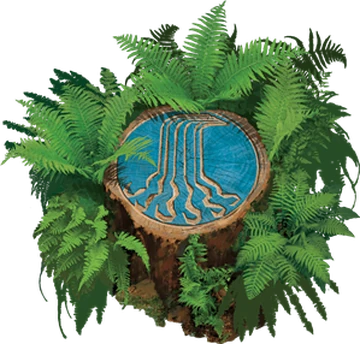
Tenets of Faith
Eldath's dogma was pacifistic, and her followers only resorted to violence in defence of themselves, of their friends and loved ones, and of pools and groves. Worshipers of Eldath could be of any alignment, but priests were always non-evil. Druids that followed the Mother of the Waters remained neutral, while her specialty priests sometimes leaned toward good.
Devotion. My devotion to my god is more important to me than what they stand for.
Purity. Violence would stain my soul. I will not engage in it.
Protection. I will use my gifts to shield and heal those who cannot defend themselves.
Tutelage. No-one is beyond redemption. All can be shown the true way.
Mystery. There are secrets to be found in the deep silence of the Goddess. I crave them, and fear them.
Kinship. Truly, all living creatures are one. We should treat one another with respect and dignity.
Temples
Priests tend to worship and make pilgrimages to one of Eldath's nine sacred temple groves (also called fastnesses). However, small temples exist in or near great forests, and clerics tend to the surrounding community and woodlands.
Rituals
Clerics and druids of Eldath pray for their spells once per day at a time selected after great personal reflection. Prayers are usually made when bathing or floating in ponds or streams, when standing under waterfalls, and in small chambers, caves, or forest bowers given over to regular meditation.
Prayers must he performed upon awakening, at sunset, and at least once during the dark hours, and may be performed at any other rime as personally desired. In woodlands and remote wilderness areas, worship of the Green Goddess should be done unclad or as close to it as is possible in a given circumstance.
The only calendar-related ritual of Eldath, the Greening (Greengrass) is also the only regular gathering and festival of the priesthood. It is preceded by Firstflow, a festival held at different times in different locales as the ice-breaks up and the waters begin to flow.
Orders
The church of Eldath has a circle of a few peacewomen and peacemen who have formed a group known as the Arbitrators of the Quiet One. They freely go to areas of conflict and attempt to serve as mediators in longstanding disagreements that have led lo violent acts. They listen to both sides and try to find a middle ground without polarizing the issues through overt statements of moral judgment. They prefer to find resolutions that get at the heart of a problem so that once dealt with it does not flare up again in months or years.
The monastic order of Eldath is the Disciples of the Yielding Way, sometimes known as the Brothers and Sisters of the Open Palm. These monks guard sacred sites where many peacemen and peacewomen dwell and travel the countryside gathering information for isolated groves and fastnesses. They do not ever seek to provoke violence, hut arc quite deceptively deadly when defending themselves, their charges, and their holy sites.
The paladin knights order of the Forest Heart are rare and widespread and are generally found traveling as intermediaries between faithful within civilizations and those in deep forests. Despite following compassionate deities of protection, these members are not opposed to violence in the face of aggression and will actively seek out peaceful wilderness locations which have been spoiled, diseased, blighted, or otherwise damaged. Slaying anyone or anything would be avoided except in the direst of situations - though aberrations, Malarites, Talonites, and other great evils may find themselves facing the point of a sword more swiftly. When not protecting the forest’s peace, members preach of the benefits of nature and the peaceful relaxation of finding the perfect place to unwind and reflect. Paladins of this order may freely multiclass as rangers and scouts.
Eldaths's Favor

Eldath’s favour falls on those who have made exceptional provision for peace and mercy. Her gaze alights on mortals who hold life itself in the greatest esteem, and who consider violence to be the tool of a lost soul.
Eldath’s scions are often those who have the privilege of living away from situations in which violence is a hard necessity. Hermits in the deep wood and monks secluded in monasteries are common examples.
Why did Eldath choose you as their champion?
You displayed pacifist principles at great cost to yourself.
You spend a great deal of time in the deep of the woods and the goddess came to you in a dream.
You were gravely injured by the cruelty of another, and healed in a sacred spring.
You were once a violent and evil person, but you were changed by the kindness of another and Eldath took pity on you.
You have pondered all your life on the silent mysteries of creation.
You don’t know why the goddess chose you, and you don’t even WANT her judgmental brand of help.
EARNING PIETY
Solving a crisis through nonviolence
Healing or caring for the sick
Taking time alone to observe silence and meditation
LOSING PIETY
Violence except as a last resort (and even that requires absolution)
Causing chaos or a loud disturbance in the calm
#dnd#dnd lore#dnd pantheon#dungeons and dragons#goddess Eldath#dnd deity#dnd cleric#dnd druid#dnd paladin#paladin oath of the ancients#cleric nature domain#cleric life domain#cleric peace domain
2 notes
·
View notes
Text



Commission - Fallen God of Madness and the Forbidden Knowledges - Travlos
Another one for the top 10
He took an incredible amount of time to paint, I worked on page by page, tattoo by tattoo, but it was so cool!
Materials I used:
Wacom Intuos Draw Tablet
Colors and Edit: Photoshop CC2018
Characters belong to BloodAngelsCaptain1
Do not use or repost without permission
#art#illustration#digitalart#rpg#ttrpg#dnd#dungeonsanddragons#dndcommission#dndart#fantasy#characterdesign#ttrpgcharacter#ttrpgcharacterdesign#dndcharacterdesign#dndcharacter#silvion#fallen god#pantheon#fallen gods#dnd pantheon#ttrpg pantheon
9 notes
·
View notes
Photo

Atrice Card
Atrice: The Divine of water/sadness. After seemingly being abandoned by her family Atrice ran away crying, making the rivers and the ocean. After she was done she went to the deepest part of the ocean to live for the rest of eternity.
Divine 1/18 for my homebrew D&D pantheon.
13 notes
·
View notes
Text
Pantheon of Chronair
The world I built has a small pantheon of Gods that most people know of and worship to some extent. So here they are!
Brogdir- Dwarvish God of the Earth (Lawful Neutral). It is believe that his whole body is what makes up the land, metals pulled out of the earth are his bones, and jewels are pieces of his soul. These are gifts that he expects his people, dwarves, to make good use of and share with the rest of the world. Mining, welding, and jewel-crafting are revered practices for people who worship him, and most are expected to take on one of these crafts, even non-dwarves who have made their home on dwarf lands.
Seriteris- Elvish Deity of the Heavens and head of the Pantheon (Chaotic Good). Due to differing dialects of Elvish, when the world was first made, two sets of Elves had a disagreement about the name and nature of this god. The beliefs drove a wedge between them and they went their separate ways, eventually becoming Sun and Moon Elves. Very few know about the true name and origin of this god, instead worshipping one of two derivatives.
Serit- The Celestial Ray. They are responsible for the warmth that comes to the world during the day and the ability to feel it. Sun Elves are expected to share that warmth to all the lands over, so that all may know and rejoice in it.
Teris- the Celestial Beam. They are responsible for the sanctity of nighttime and the ability to see beyond the scope of normal understanding. Moon Elves are expected to invite people to share in this ethereal splendor and learn from it.
Valortia, Infernal Goddess of Light and Dark (Lawful Good). She’s in charge of balance in the world, striving for darkness to be understood and for light to not be misused. It is within the laws of her religion that she always be depicted with all her Infernal features: horns, cloven hooves, forked tail, and a distinctive pair of bat-like wings. Unlike most gods, people of her bloodline can either come out as Tieflings or Aasimar. If lineage can be proven, both are equally revered.
Cain, God of Life and Spirit (True Neutral). While human in appearance, he is more often worshipped by Wood Elves than by humans. He is the least worshipped of the gods, simply because he only wants people to pay respects to the lands they live on and doesn’t care for intense worship. He is content this way, and people who worship him pay respects by either being one with the forests that he is claimed to have grown, or by going to other lands and helping them reach their full potential of life.
Krokna, Draconic Goddess of the Sea (Chaotic Neutral). She is believed to be the only one of the gods to still roam the planet, living deep in the bowels of the oceans that surround Chronair. She is rarely worshipped by anyone outside of the Dragonborn that live on the Scattered Scales, although many are quick to blame her for sunken ships or unfair weather during sea voyages. Nobody is sure what color her scales are, so she is often depicted with a rainbow-like visage. It's considered deeply disrespectful to depict her as only one color.
#dnd#dnd 5e#dungeons and dragons#dungeon master#homebrew#homebrew pantheon#dnd gods#dnd pantheon#homebrew gods#general lore & world building
5 notes
·
View notes
Photo

why be silly when you can be silly and sexy?~
my take on Oberon the Green Lord from my DnD setting... I’m slowly working on his body as of posting this
#my art#song-of-the-sunrise#dnd#dnd gods#dnd art#dnd satyr#dnd green lord#oberon#lord oberon#dnd pantheon#my characters#digital art#clip studio paint#CLIP Art Studio#reblogs welcome#feel free to share#and feel free to#ask me anything#about my characters
2 notes
·
View notes
Text
Divine Family Trees (2 of them) + I need help!
So, my DnD setting is the result of a campaign I was in years ago where the planes of Toril and Oerth were colliding, including the relationships the gods had with one another as all of the Oververse was shuffled. The result is my setting, where the gods of the Forgotten Realm and Greyhawk exist side by side.
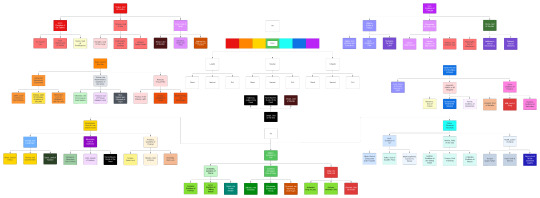
We have two models for the divine in this setting, the Familial Model, and the Aoen Mysteries Model. The Familial model is more narrative-based, gods having children and whatnot - you know, a family. The Aoen Mysteries are more... Esoteric and based off of a madman and also former worldleader, Archomonarch Bastien Jortel. The basic concept is that AO split himself into seven, then those seven split themselves into three (following Law, Neutral and Chaos), and then those three split themselves off into another three (Following Good, Neutral, and Evil). The basic premise of the Aoen Mysteries is that each god isn't really its own entity, but rather a fragment of the greater Godhead. Jergal, representing the End of all Things, is seen as separate from the Godhead. The downside with this is, unfortunately, I need to come up with 95 Gods... I'm currently at 92 - so if anyone can think of who would be a good derivative of Azuth, or how I should reorganize, let me know.

In the Familial Model, AO created Their children every time it came up with a new idea, creating the 12 in the first generation (Thought, Ending and Tme, 4 Elemental Gods, then Life, Change, Darkness, Conflict, and Passion). From there, AO gave them the ability to create their own children, and eventually, Pelor, Mystryl, Targus and Avandra all schemed to steal the ability to create Soul. In this act, Asmodues cut out AO's heart and hid it beneath his Mountain, while the other gods scattered AO's essence into the Elemental Chaos. It wasn't until Karsus (because he's in the Zietgeist right now) tried to ascend to Godhood by recalling the fragments of AO to himself that Tharizdum appeared. Made of all AO had left, Tharizdum is pure malice and greed incarnate. It wants to absorb everything back into itself so that It may never again be threatened. This, of course, is a big ol secret, and to most people, AO is asleep (as like... the laws of physics or some shit) and Tharizdum is separate from the Godhead.
Feel free to ask more in the comments!
#bg3#dnd homebrew#dnd5e#dnd#dnd oc#dnd home game#homebrew#dnd 5e homebrew#pantheon#custom pantheon#god#goddess#gods#original mythology#dnd pantheon
1 note
·
View note
Text
Ah yes. My tabletop campaigns pantheon...
A helicopter parent (a bee, technically), a regular looking man (who rules the fiery abyss), Miss "I sit in ponds all day" (a dragon), a dude "imprisoned for fathering too many weird children"(a dragon), a twitch streamer who has an insatiable warlike bloodlust (a dragon), a silly lil gal who was criminalized for making the clouds into funny shapes (She wore peoples faces. Also a dragon)
I could name more but you are never gonna guess what they are. (definitely not more dragons)
#dragons#dnd#d&d#dungeons and dragons out of context#dungeons and dragons#dungeons & dragons#dungeon master#dm#tabletop roleplaying#tabletop games#tabletop rpg#chronicle vii#eelslippers#dnd out of context#pantheon#dnd pantheon#dnd campaign#ok but fr i could name more if anyone actually is curious like deadass#the pantheon is very large#theres like 8 different gods of magic who all each represent a different school of it#plus their mother#and like the goddess of enchantment has atleast three or four named children and a husband she commits warcrimes with#two of the entities in the pantheon are technically not deities but Something Else but i couldnt actually describe them without spoilers#those are just the main deities too like fr the pantheon is limitless
1 note
·
View note
Text
I just love clerics. I just love explorations of faith and devotion in a world where gods are provably real and also provably not omnipotent. I love obsession I love devotion I love giving your everything for an ideal or the approval of a higher being who can't or won't be devoted to you in return
#i love the faerunian pantheon especially. so many cool creatures in there#i just love a guy who's so obsessed with one thing. clerics and paladins man#ITS SO GOOD ITS SO JUICY ITS SUCH A BOLD CHARACTERISATION CHOICE#dnd#clerics#this is also partially about#bg3#d20#fantasy high
489 notes
·
View notes
Text
#dnd#d&d#dungeons and dragons#dungeons & dragons#polls#fuck it i want to show people my pantheon#it isn't all of them but it's most of them
479 notes
·
View notes
Text
Sometimes I think back to when I made a dnd world based on North Amercia, but with a Greek style pantheon and city states. Fantasy races were replaced with cryptids, and every ranged weapon was reskined as a gun.
This was the main pantheon:
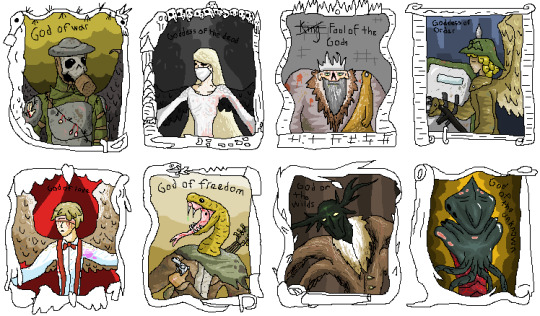
This was the map of the known world:

It was a really nice setting while it lasted. But I've moved on from 5e to running other rpg systems now, so I don't really have a chance to do much with this setting since it was so closely tied to 5e.
Mabye someday.
#worldbuilding#fantasy#dnd#dnd art#d&d#d&d art#my thougts#my worldbuilding#fantasy world#fantasy worldbuilding#my artwork#my art#cryptid creature#cryptidcore#cryptids#cryptid#gods#mythology#classical mythology#pantheon#fantasy map#map#maps#ttrpg#rpg#homebrew#gming#dming
70 notes
·
View notes
Text
Greek Pantheon dnd minis
yeah i was a gay and neurodivergent child in the 2000's, of course i was obsessed with greek mythology
Zeus
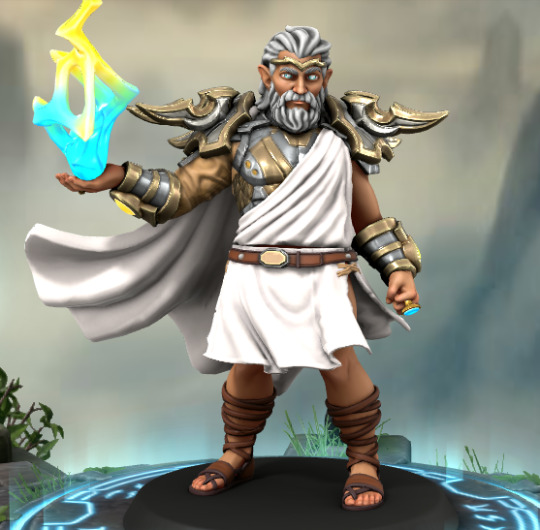
Posiedon

Hades

Hera
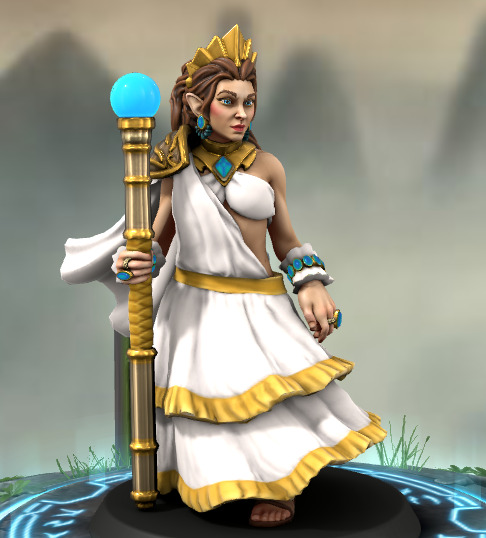
Demeter
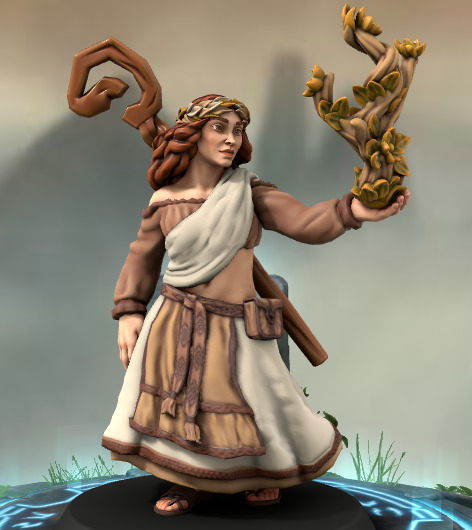
Hestia

Athena

Ares

Aphrodite

Apollo
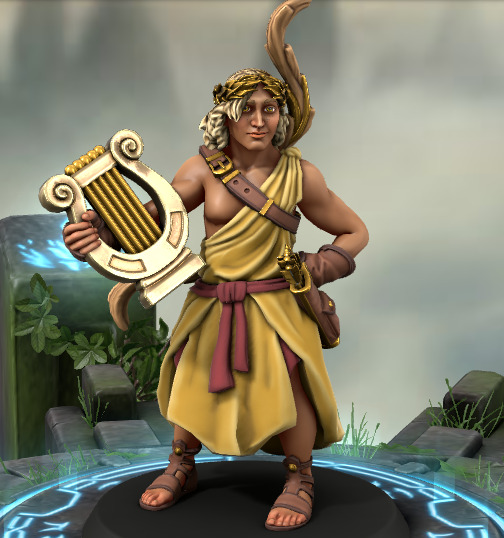
Artemis
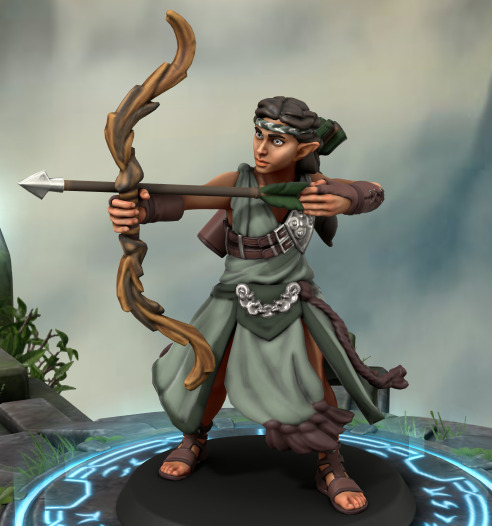
Hephaestus

Hermes
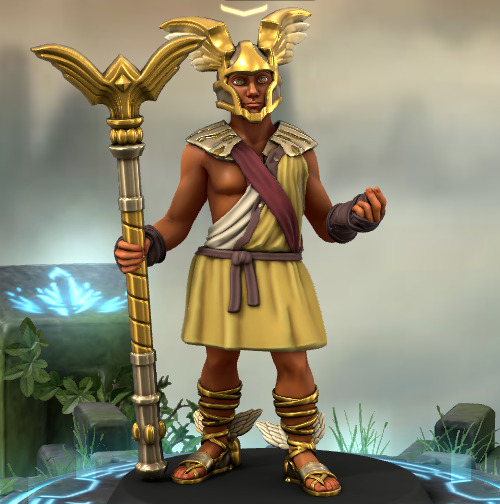
Dionysus
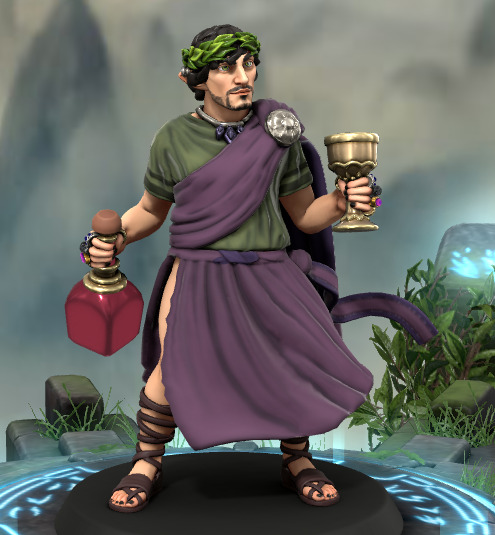
Persephone

i might do more idk
#d&d#dnd#dnd miniatures#dnd minis#dungeons and dragons#greek mythology#greek gods#greek pantheon#percy jackon and the olympians#percy jackson#hercules#zeus#posiedon#hades#hera#demeter#hestia#athena#ares#apollo#artemis#hephaestus#hermes#dionysus#persephone#ancient greece#hero forge
27 notes
·
View notes
Text

Drew some gods of my own Pantheon!! They've been overdue for some art
#dnd#digital art#dungeons and dragons#sketch#d&d character#anthro#my art#digital artist#furry#pantheon#sketches#bust ups#Bust up#artists on tumblr
19 notes
·
View notes
Text



Commission - God of Light and Hope - Elphos
Cropped armor
Materials I used:
Wacom Intuos Draw Tablet
Colors and Edit: Photoshop CC2018
Characters belong to BloodAngelsCaptain1
Do not use or repost without permission
#art#illustration#digitalart#rpg#ttrpg#dnd#dungeonsanddragons#dndcommission#dndart#fantasy#characterdesign#ttrpgcharacter#ttrpgcharacterdesign#dndcharacterdesign#dndcharacter#dnd pantheon#silvion#ttrpg pantheon#pantheon#armor#armor design#dnd armor#ttrpg armor
4 notes
·
View notes
Text
THEME: Gods & Myth
This week's recommendations are for games that give you the ability to play gods or the children of gods.
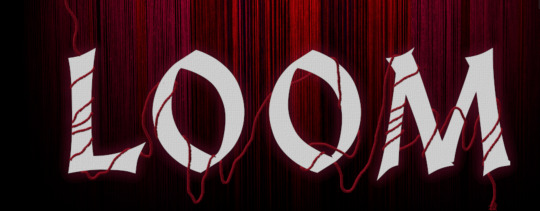

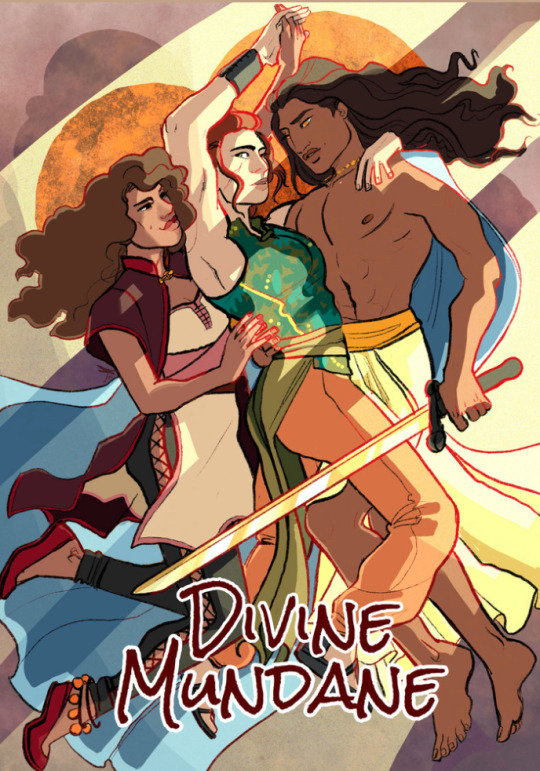





LOOM by Yuigaron
The Knot hangs ponderous, heavy - pulling taut the tangled threads of the Fabric Between Worlds. Tired, callused hands pick at the threads, easing the tangles, bit by aching bit. Slowly, deliberately, they pull at loose threads to scrutinize with weary eyes, as they mutter amongst themselves. Piles of threads form at their feet, growing ever larger, until the eldest amongst them finally speaks. ‘That is… enough. For now. With these Thrums - these tangled, fraying threads - They can return.’
The others simply nod, and gather together what threads they have found.
The eldest stares at The Knot that threatens all that exists in the worlds, ‘The rest… is up to Them.’
LOOM is a Fantasy Action TTRPG where players take on the roles of fallen Gods - tricked out of their Domains - trying to reclaim their seats of power. LOOM is a combat heavy game taking inspiration from video games like Hades. This game is Illuminated, and is made using the LUMEN system created by Spencer Campbell of GilaRPGs.
The LUMEN system is designed for action-packed games, and uses only d6s for the whole of the game. LOOM also contains an Overload system, which is meant to represent the cost of immortality: the Gods may persist, but at the cost of their powers. The key to regaining your power is unraveling the Knot, which contains unknown dangers along every Thread. If you like the idea of choosing your own rewards while facing unknown hordes of foes, LOOM might be worth checking out! Right now it's just the ashcan version, but it's funding on itch.io.
Godsend by UFO Press
These are times of trouble: the days are numbered. Legends told us about them. We have names for them in our sacred scriptures: the Ragnarök, the War of Gods, the Apocalypse, the Arrival of Avatars, the Eternal Night, the Infinite Void. The end of days.
But we are not alone, we are not powerless: the gods are walking among us. They are here to guide us, to save the world as we know it – or to help us reach the land of the Dead. If we pray faithfully enough and prove our worthiness, perhaps we can be spared.
In Godsend you roam the lands as the avatar of your god, cursing mere mortals and presenting gifts to the chosen ones. Your memories are numerous, made of the lives of your predecessors, your power is almost limitless. Will you use it to fulfil the will of your god? Or, as the end times draw near, will you try to save the world?
Godsend uses the same system as Legacy: Life Among The Ruins, which is Powered by the Apocalypse. However, this game doesn't use dice at all; instead players will be forced to make choices about what can happen based off of the stats and abilities they select at character creation. (You're gods, you don't leave things up to chance!) Each player has two playbooks to control: a god and the god's avatar. As you play through four ages, the gods may rise and fall, while their avatars may ascend to become gods in their own right.
Divine || Mundane by Hamblet Games
You are a god of good, of light and truth. You are god of evil, of rot and decay. You are a mortal hero, steadfast and loyal in a world of the divine.
Divine || Mundane is a game in which you build a world together and find out what happens when gods clash with mortals and with each other, when rivals must work together, when enemies become lovers, when war brings people closer.
Divine || Mundane uses the Firebrands system, which is built off of a series of mini-games the players will engage in. It's very similar to to Powered by the Apocalypse games in that you play to find out what happens, rather than exploring a narrative that the GM sets up beforehand.
SCION 2e by Onyx Path
You are the child of a God, born to the magic of yesterday and the promise of tomorrow. You live in a World of myth, where every ancient story is true. Your ancient enemies, the Titans, stir in their prison beneath the lands of the dead. Their spawn issues forth from lands of myth, and the spectre of war falls across the heavens. In this age of turmoil, you seize your birthrights and feel the call of your blood.
Find your destiny. Live the myth. Embrace your Fate.
Scion is a game about Gods and humanity, and everything in between. It’s a game about mythic Deeds and the reasons people talk about those mythic Deeds. Scion: Origin details the Scions when they’re still (mostly) human, before the Visitation that introduces them to the divine World — they’re exceptional humans, perhaps, blessed with luck and skill or cursed with ill fortune and strange trials in their lives, but humans nonetheless.
Scion underwent a big upgrade with its second edition, from sensitivity readers, to an expansion of the rules to allow for the inclusion of gods not listed in the book's lore sections. The books are split up according to power levels, so Origin will give you the basics, but Hero will get your characters to the level at which legends are made. Demigod is out, and God is currently in production. The books themselves are on the pricier side of things, and the the index leaves a lot to be desired, but if you're looking for a system with a wealth of options, a lot of inspiration, and mechanics that prize investigation and social scenes just as much as combat, Scion 2e might be worth checking out.
Part-Time Gods, by Third Eye Games
Long ago, an entity known as the Source visited humanity and gifted certain people with divine power. For a time, the world existed in a state of balance between order and chaos, between life and death, between divinity and mortality. That is, until the gods waged war against the Source and eventually against each other, until the gods were close to extinct.
The gods of today are shadows of what the old gods possessed. Their power has been heavily diminished, and many choose to live a regular, mortal life, revealing themselves as gods only when absolutely necessary.
The gods exist today in a state of flux. They have a mortal life, a job (or career if they’re lucky), friends, family, and everything that comes with being human, and they work hard to protect these things from harm. On the other side of the coin, they also have a Dominion to command and oversee, a deific Territory to defend from intruders, secret societies to which they owe allegiances (called Theologies), and other gods in their pantheon to try to get along with. This becomes their life, the balancing of the mortal and the divine, the normal and the supernatural, the mundane and the strange. The gods belong not to either world completely, and each of them knows that delving too deeply into one means losing pieces of the other.
Part Time Gods requires a large amount of d10s, and optionally, poker chips or some other token that can represent Free Time and Wealth. Character creation is flexible enough to bring a concept to the table and build toward it, while still containing complexities that dive into different pieces of your character's personality, from their Occupation to their Archetype to their Theology. Your character will have a combination of practical skills and supernatural manifestations to wield when problems come their way. If you like a heavy amount of lore, a lot of moving pieces to keep track of, and the theme of balancing both mundane responsibilities and supernatural birthrights, Part Time Gods is the game for you.
Our Minerva by Vagabond Pen & Paper
Pilgrims come from the far reaches of the Microcosmic Plane, from the various worlds over which the divine rule. They undertake a great journey across the stars to offer their services to the divine in Sport.
In private though, far away from the cameras and microphones of Coliseum, they whisper of ulterior motives for their athletic exploits, both benign and sinister. It has even been said that some give voice to the heretical lie that they come from other planes altogether, beyond the domain of the gods both dead and undead. A claim as impossible as it is profane.
Our Minerva is a GMless, slice-of-life tabletop roleplaying game about the athlete children of undead gods. You'll portray their exploits in Sport, their responsibilities in Duty, and especially their interactions and relationships in a quiet, rural Town where they never actually lived. Our Minerva is the sequel to Revenant World: A science-fantasy tabletop role-playing game about brave kids and undead gods. It stands on its own, but takes place in the same universe, 150 years later, incorporating and reimagining elements from the first game.
Instead of dice, you'll use a pack of playing cards to draw out the narrative. This game is great if you like the idea of mythology combining with the teenage struggles of romance and teamwork. It's also a great option for groups without a GM, or where the GM would like to take a bit of a break.
Heart and Lightning by Swords and Flowers
You are Daughters of Lightning, a rider of storms, and breaker of mountains. You are warriors, lovers, and legend.
You are also teenagers.
Barely of age for the throne, you have been kicked out of your immortal homeland and stripped of your powers for another one of your stupid (brave!) antics (deeds!!!). As outcasts, you must work together, prove yourselves, and return home.
HEART & LIGHTNING is a rock-inspired, sword and sorcery tabletop roleplaying game about teenage gods, rebellion, and the troubles they get into. Play as the Daughters of Lightning, almighty children who embody storms, its power, rage and tenacity. Stubborn and young, you've recently been evicted from your heavenly home and must complete a quest to return.
One of the elements of HEART & LIGHTNING that really stands out is the character creation. You have two main traits and three side traits. Then each character chooses a Domain, a Gift, and a Talent. You can mix and match these options to create the Daughter of your choice. For GMs, there's a number of factions to play with, and a horde of npcs and antagonists to pick up and drop into your game. The rolling mechanic uses 2d6 and a graded success, like most PbtA games. If you like playing to find out, and more character customization options than a regular PbtA game gives you, you should check this one out!
AGON by John Harper
In the mists of ancient time, a poet sings of great deeds wrought by mighty heroes—of monsters slain and justice restored, of wise counsel and devious strategies, of courage, valor, and daring—defiant of the gods themselves.
In AGON, you create these heroes, crafting their epic tale into an immortal legend. On their way back home from war, a band of heroes become lost among strange islands populated by mythical creatures, dangerous villains, legendary kingdoms, and desperate people—each entangled in strife, at the mercy of the capricious gods.
AGON is designed for session-contained play that is easy to contain in 2-3 hours thanks to a streamlined rolling system. Characters will increase in power and fame with every great deed, and their actions will inform both the abilities they gain and the legacy they leave behind. AGON uses a number of different dice - from d6s to d12s - and is the parent of the PARAGON system, which is a new but quickly-growing family of games. If you like self-contained sessions with an emphasis on storytelling and minimal work for the GM, AGON is for you.
164 notes
·
View notes
Text
No ones ready for my crazy ass bg3 fic where my canonically dead dnd character gets fucking isekai’d into bg3 (aka faerun) by bhall and is forcibly turned into a bhallspawn instead of dying his deserved but unwarranted death
#bg3#baldurs gate 3#dnd#especially since like almost everything from that campaign was homebrew#and has a completely different pantheon#bro does not know whats happening#he will fully say ‘wtf is a baldurs gate’ at some point LMAO#im gen so excited to write this fic btw like!!!#it works too well for me to not do it LMAO
21 notes
·
View notes
Text
shoutout to all the dungeon masters getting new character ideas from players with backstories that involve the forgotten realms pantheon (shar & selune especially) after the cultural wave of BG3 - even though your homebrew worlds uses a different pantheon of gods
#its me shoutout to me#but shout out to all of u homebrew dms too#i dont mind it as much. bc i can just 'mod' them into my game as minor deities but yeah#someone pls make a hit videogame that uses the dawn war pantheon (or better yet. the exandria pantheon)#so that i can have something that CATERS SPECIFICALLY TO ME (dont attack me) that i can show to my players.#KLJHFSDKLFJHASDKL#dnd#dungeons and dragons#bg3#baldurs gate 3#homebrew
8 notes
·
View notes